
|
Now it is very bright as 8.7 mag (Feb. 14, Thomas Lehmann). It brightened temporarily in outburst in early January, but it returned to the original brightness. It will pass close to the earth from spring to summer, and it is expected to brighten up to 5-6 mag. In the Northern Hemisphere, it will be unobservable in late February. It will appear in the morning sky again in late April, but it locates low in the south around the high light. In the Southern Hemisphere, it is not observable now. But after appearing in the morning sky again in mid April, it will be observable in excellent condition.
Date(TT) R.A. (2000) Decl. Delta r Elong. m1 Best Time(A, h)
Feb. 20 23 35.48 8 16.8 2.384 1.591 28 8.4 20:19 ( 91,-13)
Feb. 27 23 35.02 7 17.5 2.413 1.536 21 8.2 20:08 ( 87,-16)
|
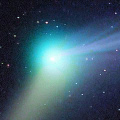
|
Now it is 7.8 mag (Feb. 12, Maik Meyer). It was expected to brighten up to 4-5 mag from autumn to winter. But actually, it was 6 mag at best. It will be fading rapidly after this. It is observable in excellent condition in the Northern Hemisphere. It is not observable after this in the Southern Hemisphere.
Date(TT) R.A. (2000) Decl. Delta r Elong. m1 Best Time(A, h)
Feb. 20 4 14.93 64 7.0 1.380 1.839 100 9.0 20:19 (167,-12)
Feb. 27 4 9.41 59 49.9 1.591 1.932 94 9.6 20:08 (162, -9)
|

|
Now it is so bright as 9.2 mag (Feb. 12, Maik Meyer). It is observable at 9-10 mag until spring in excellent condition in the Northern Hemisphere. It keeps unobservable in the Southern Hemisphere.
Date(TT) R.A. (2000) Decl. Delta r Elong. m1 Best Time(A, h)
Feb. 20 15 46.58 69 41.4 1.832 2.265 102 9.5 4:07 (189,-16)
Feb. 27 15 12.20 70 50.5 1.829 2.296 105 9.6 4:16 (183,-16)
|

|
Now it is bright as 12.4 mag (Jan. 9, Seiichi Yoshida). It keeps 12 mag for a long time from 2015 autumn to 2016 summer. In the Northern Hemispehre, it keeps observable in good condition for a long time. It keeps unobservable in the Southern Hemisphere.
Date(TT) R.A. (2000) Decl. Delta r Elong. m1 Best Time(A, h)
Feb. 20 20 28.71 64 43.4 2.696 2.678 78 12.1 4:07 (211,-34)
Feb. 27 20 32.18 64 46.0 2.714 2.673 77 12.1 4:16 (210,-30)
|
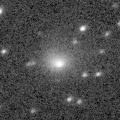
|
Now it is 13.2 mag (Feb. 12, Thomas Lehmann). It will brighten up to 11 mag from spring to summer. In the Northern Hemisphere, it keeps observable in good condition while the comet will be brightening. It locates somewhat low in the Southern Hemisphere.
Date(TT) R.A. (2000) Decl. Delta r Elong. m1 Best Time(A, h)
Feb. 20 5 5.24 20 32.7 1.637 2.141 106 12.9 20:19 (160, 32)
Feb. 27 5 9.72 20 53.1 1.679 2.101 100 12.8 20:08 (157, 31)
|
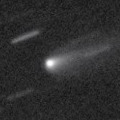
|
Now it is 13.3 mag (Jan. 9, Seiichi Yoshida). It will brighten up to 13 mag from winter to spring. It will be observable in excellent condition in the Southern Hemisphere. But it locates somewhat low in the Northern Hemisphere.
Date(TT) R.A. (2000) Decl. Delta r Elong. m1 Best Time(A, h)
Feb. 20 15 29.21 -19 29.5 1.874 2.205 95 13.4 4:07 (236, 66)
Feb. 27 15 37.45 -20 11.0 1.802 2.212 100 13.4 4:16 (224, 71)
|
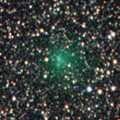
|
Now it is 11.8 mag (Jan. 8, Giuseppe Pappa). It will be unobservable soon. It will appear in the morning sky in summer, but it will be fainter than 17 mag.
Date(TT) R.A. (2000) Decl. Delta r Elong. m1 Best Time(A, h)
Feb. 20 0 7.67 -7 53.5 2.530 1.734 29 13.5 20:19 ( 82, 3)
Feb. 27 0 25.53 -6 1.2 2.597 1.773 27 13.7 20:08 ( 84, 2)
|
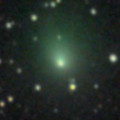
|
It is not observable now. It will appear in the morning sky in June. But the comet will be faint as 16-17 mag.
Date(TT) R.A. (2000) Decl. Delta r Elong. m1 Best Time(A, h)
Feb. 20 22 55.95 -9 18.5 2.900 1.940 11 13.7 20:19 ( 71,-11)
Feb. 27 23 12.03 -7 45.6 2.952 1.979 8 13.9 20:08 ( 72,-12)
|

|
It brightened up to 3.7 mag and became a naked eye comet in mid January in 2015 (Jan. 13, Marek Biely). Now it is fading. It has already faded down to 14.6 mag (Jan. 26, Ken-ichi Kadota). In the Northern Hemisphere, it keeps observable for a long time until the comet fades out. It is appearing in the morning sky also in the Southern Hemisphere.
Date(TT) R.A. (2000) Decl. Delta r Elong. m1 Best Time(A, h)
Feb. 20 18 24.31 21 9.4 5.206 4.860 64 13.8 4:07 (238, 7)
Feb. 27 18 27.10 21 35.6 5.204 4.925 68 13.9 4:16 (233, 12)
|
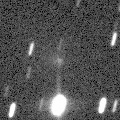
|
Now it is 14.0 mag (Feb. 11, Michael Jager). It will pass only 0.036 a.u. from the earth on Mar. 21-22. It is expected to brighten very rapidly and reach up to 11 mag in March. In this apparition, it keeps observable in excellent condition both brightening and fading period. In the Northern Hemisphere, it will be unobservable temporarily in mid March. The orbital elements are similar to those of P/2016 BA14 ( PanSTARRS ).
Date(TT) R.A. (2000) Decl. Delta r Elong. m1 Best Time(A, h)
Feb. 20 5 47.92 -26 31.0 0.181 1.053 105 14.5 20:19 (140, 80)
Feb. 27 5 46.07 -30 1.9 0.144 1.025 100 13.9 20:08 (111, 79)
|

|
Appearing in the morning sky in the Southern Hemisphere. It will be observable soon also in the Northern Hemisphere.
Date(TT) R.A. (2000) Decl. Delta r Elong. m1 Best Time(A, h)
Feb. 20 19 20.97 -26 30.3 6.651 5.962 42 13.9 4:07 (287, 23)
Feb. 27 19 26.15 -26 19.8 6.570 5.959 48 13.9 4:16 (283, 29)
|
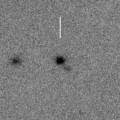
|
Now it is 17.9 mag (Jan. 19, Ken-ichi Kadota). It will be observable at 11 mag in good condition from spring to summer. It is much fainter than this ephemeris recently. But it will start brightening rapidly soon.
Date(TT) R.A. (2000) Decl. Delta r Elong. m1 Best Time(A, h)
Feb. 20 12 29.40 16 21.9 1.267 2.158 145 14.9 2:33 (180, 39)
Feb. 27 12 27.50 17 17.9 1.194 2.119 151 14.5 2:04 (180, 38)
|

|
Now it is 15.1 mag (Dec. 30, Mitsunori Tsumura). Distant object, but it keeps observable at 14-15 mag for a long time from 2015 to 2016. It becomes unobservable temporarily from January to March in the Southern Hemisphere, or from February to April in the Northern Hemisphere.
Date(TT) R.A. (2000) Decl. Delta r Elong. m1 Best Time(A, h)
Feb. 20 22 43.58 -4 44.5 5.903 4.934 10 14.8 20:19 ( 72,-16)
Feb. 27 22 50.79 -4 15.8 5.911 4.927 5 14.8 20:08 ( 71,-18)
|
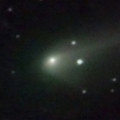
|
It brightened up to 11.1 mag in 2015 autumn (Sept. 21, Seiichi Yoshida). Now it is 14.5 mag (Feb. 15, Thomas Lehmann). It keeps observable in good condition after this, while the comet will be fading gradually.
Date(TT) R.A. (2000) Decl. Delta r Elong. m1 Best Time(A, h)
Feb. 20 12 7.42 10 20.0 1.488 2.402 151 14.9 2:12 (180, 45)
Feb. 27 12 0.21 11 4.6 1.503 2.455 159 15.0 1:37 (180, 44)
|
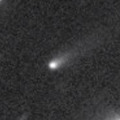
|
Now it is 16.7 mag (Dec. 11, D. Buczynski). It is observable at 14-15 mag in good condition from winter to summer.
Date(TT) R.A. (2000) Decl. Delta r Elong. m1 Best Time(A, h)
Feb. 20 13 44.13 -4 44.9 1.698 2.401 124 15.3 3:48 (180, 60)
Feb. 27 13 43.41 -5 47.4 1.618 2.390 131 15.1 3:20 (180, 61)
|
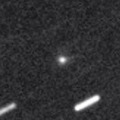
|
Appearing in the morning sky. It will be observable at 14 mag in good condition from spring to summer.
Date(TT) R.A. (2000) Decl. Delta r Elong. m1 Best Time(A, h)
Feb. 20 18 38.01 -18 1.1 2.985 2.496 51 15.3 4:07 (273, 28)
Feb. 27 18 51.56 -17 44.3 2.907 2.483 55 15.3 4:16 (270, 32)
|
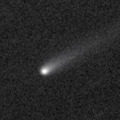
|
It brightened very rapidly in 2015 spring, and reached up to 13.8 mag (May 11, Sandor Szabo). It is bright as 14.8 mag still now (Jan. 24, Ken-ichi Kadota). It keeps 15 mag for a while until spring. It is observable in excellent condition in the Southern Hemisphere. But it locates somewhat low in the Northern Hemisphere.
Date(TT) R.A. (2000) Decl. Delta r Elong. m1 Best Time(A, h)
Feb. 20 14 15.16 -28 45.2 3.450 3.882 108 15.5 4:07 (203, 83)
Feb. 27 14 16.03 -29 13.8 3.381 3.905 115 15.5 3:52 (180, 84)
|
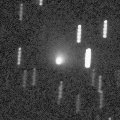
|
It kept brightening even after the perihelion passage, and brightened up to 13.0 mag (Dec. 21, Juan Jose Gonzalez). It keeps observable in excellent condition for a while. But it will be fading after this. It has already faded down to 15.4 mag (Jan. 29, Sandor Szabo).
Date(TT) R.A. (2000) Decl. Delta r Elong. m1 Best Time(A, h)
Feb. 20 5 51.03 25 40.6 1.084 1.772 117 15.7 20:19 (173, 29)
Feb. 27 6 2.58 26 49.4 1.177 1.809 112 15.9 20:08 (172, 28)
|
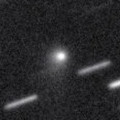
|
Now it is 15.7 mag (Dec. 19, Y. Sugiyama). It keeps 15-16 mag for a long time until 2016. It keeps observable in excellent condition in the Northern Hemisphere. It keeps unobservable in the Southern Hemisphere.
Date(TT) R.A. (2000) Decl. Delta r Elong. m1 Best Time(A, h)
Feb. 20 2 45.77 72 30.2 5.114 5.285 94 15.8 20:19 (165,-23)
Feb. 27 2 50.37 72 19.8 5.193 5.296 90 15.8 20:08 (164,-24)
|
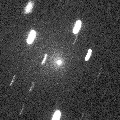
|
It passed near by the earth and brightened up to 12.1 mag from mid December to early January (Dec. 20, Thomas Lehmann). It must be fading very rapidly now. No observations have been reported in February. It is observable in excellent condition in the Northern Hemisphere. It is not observable in the Southern Hemisphere.
Date(TT) R.A. (2000) Decl. Delta r Elong. m1 Best Time(A, h)
Feb. 20 2 55.97 44 4.5 1.923 2.083 84 15.8 20:19 (146, -1)
Feb. 27 2 56.85 41 51.1 2.136 2.157 77 16.2 20:08 (143, -2)
|
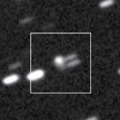
|
Now it is 16.4 mag (Jan. 15, Thomas Lehmann). It is expected to brighten up to 7 mag in 2017 summer. In the Northern Hemisphere, it keeps observable in good condition until the highlight while the comet will be brightening. In the Southern Hemisphere, it is not observable until early 2017.
Date(TT) R.A. (2000) Decl. Delta r Elong. m1 Best Time(A, h)
Feb. 20 6 55.33 63 52.2 5.031 5.555 117 16.0 20:56 (180, -9)
Feb. 27 6 49.90 63 32.9 5.044 5.495 112 15.9 20:24 (180, -9)
|
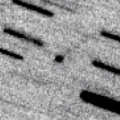
|
First return of an object discovered as an asteroid 2007 VA85 in 2007. Faint tail was observed on Jan. 8 by Hidetaka Sato. It approached to the earth down to 0.5 a.u., and brightened up to 15.3 mag in February (Feb. 10, Katsumi Yoshimoto). It will be fading and getting lower after this. It will be unobservable in mid March in the Southern Hemisphere, or in late April in the Northern Hemisphere.
Date(TT) R.A. (2000) Decl. Delta r Elong. m1 Best Time(A, h)
Feb. 20 5 18.70 -7 35.9 0.578 1.268 105 16.2 20:19 (150, 58)
Feb. 27 4 38.11 6 17.3 0.703 1.226 91 16.6 20:08 (140, 39)
|
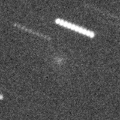
|
Now it is 16.5 mag (Feb. 11, Michael Jager). The brightness differs in every apparition. It was not observed in the last apparition. In this apparition, it was expected to be observable at 14-15 mag from winter to spring. But probably it will be 16 mag at best. It locates extremely low in the Southern Hemisphere.
Date(TT) R.A. (2000) Decl. Delta r Elong. m1 Best Time(A, h)
Feb. 20 0 37.81 5 56.6 1.845 1.268 40 16.4 20:19 ( 98, 1)
Feb. 27 1 1.11 7 34.2 1.833 1.239 39 16.2 20:08 (100, 1)
|
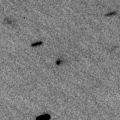
|
Now it is 16.9 mag (Nov. 17, J. Nicolas, C. Rinner, F. Kugel, A. Klotz). It will brighten up to 14 mag in 2017. In 2016, it keeps observable at 16 mag in good condition from winter to spring.
Date(TT) R.A. (2000) Decl. Delta r Elong. m1 Best Time(A, h)
Feb. 20 12 1.08 12 35.6 3.002 3.909 152 16.3 2:05 (180, 43)
Feb. 27 11 57.42 13 7.2 2.948 3.893 159 16.2 1:34 (180, 42)
|
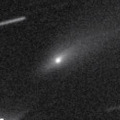
|
Now it is 15.8 mag (Dec. 7, Yuji Ohshima). In the Northern Hemisphere, it keeps observable in good condition after this while the comet will be fading. It locates low in the Southern Hemisphere.
Date(TT) R.A. (2000) Decl. Delta r Elong. m1 Best Time(A, h)
Feb. 20 14 22.98 25 51.9 2.324 2.933 118 16.2 4:07 (185, 29)
Feb. 27 14 20.70 26 53.5 2.307 2.979 124 16.3 3:57 (180, 28)
|

|
It brightened up to 11-12 mag in 2012. It has already faded down to 17.2 mag (Dec. 19, Yuji Ohshima). It is observable at 16-17 mag in good condition from winter to spring.
Date(TT) R.A. (2000) Decl. Delta r Elong. m1 Best Time(A, h)
Feb. 20 10 52.89 -6 10.1 10.045 10.977 159 16.3 0:57 (180, 61)
Feb. 27 10 49.55 -5 52.9 10.055 11.015 165 16.3 0:26 (180, 61)
|

|
It will approach to the sun down to 0.58 a.u. on Mar. 9, and brighten up to 15 mag. But it is not observable around the perihelion passage. It will appear in the evening sky at 17 mag in late March. But it will fade out very rapidly.
Date(TT) R.A. (2000) Decl. Delta r Elong. m1 Best Time(A, h)
Feb. 20 22 31.27 -8 16.6 1.657 0.681 5 17.4 20:19 ( 68,-16)
Feb. 27 23 11.53 -5 37.0 1.578 0.620 9 16.3 20:08 ( 74,-13)
|

|
Now it is 16.9 mag (Nov. 15, J. Bel). It will brighten up to 14 mag in summer. But it is not observable at the highlight. It keeps observable until March while the comet will be brightening gradually up to 15-16 mag.
Date(TT) R.A. (2000) Decl. Delta r Elong. m1 Best Time(A, h)
Feb. 20 1 44.14 3 20.4 2.595 2.185 55 16.4 20:19 (106, 16)
Feb. 27 1 56.33 4 37.1 2.638 2.163 51 16.3 20:08 (106, 14)
|
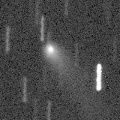
|
Now it is 15.3 mag (Dec. 13, D. Buczynski). It kept 15 mag for a long time from 2014 to 2015. But it will be fading slowly after this. It keeps observable for a long time in the Northern Hemisphere, although it becomes low in spring. It will not be observable after this in the Southern Hemisphere.
Date(TT) R.A. (2000) Decl. Delta r Elong. m1 Best Time(A, h)
Feb. 20 0 53.20 47 8.2 5.138 4.868 68 16.4 20:19 (135,-20)
Feb. 27 0 58.97 47 38.3 5.247 4.903 64 16.5 20:08 (134,-21)
|
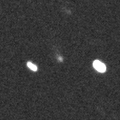
|
Now it is 16.9 mag (Dec. 13, K. Hills). It keeps 16-17 mag for a long time until 2016 autumn. In the Southern Hemisphere, it keeps observable in good condition for a long time. In the Northern Hemisphere, it is observable only until March.
Date(TT) R.A. (2000) Decl. Delta r Elong. m1 Best Time(A, h)
Feb. 20 3 38.90 -28 25.2 2.678 2.652 77 16.6 20:19 ( 90, 56)
Feb. 27 3 38.79 -28 33.3 2.725 2.615 73 16.6 20:08 ( 87, 52)
|
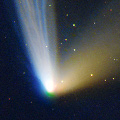
|
It approached to the sun down to 0.3 a.u. on July 6, 2015, and brighted up to 3.9 mag (July 6, Thomas Lehmann). Now it is fading. It has already faded down to 12.9 mag in October (Oct. 3, Chris Wyatt). No observations have been reported since November. In the Southern Hemisphere, it keeps observable until the comet fades out. It will not be observable after this in the Northern Hemisphere.
Date(TT) R.A. (2000) Decl. Delta r Elong. m1 Best Time(A, h)
Feb. 20 19 54.26 -58 47.8 4.318 3.821 53 16.6 4:07 (323, 30)
Feb. 27 20 5.32 -59 13.7 4.336 3.904 58 16.7 4:16 (322, 34)
|
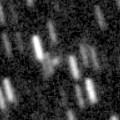
|
Now it is 17.0 mag (Nov. 3, A. Maury, J.-F. Soulier, J.-G. Bosch, T. Noel). It keeps 16.5 mag for a long time in 2016, and it will be observable in excellent condition in the Southern Hemisphere. It is hardly observable in the Northern Hemisphere.
Date(TT) R.A. (2000) Decl. Delta r Elong. m1 Best Time(A, h)
Feb. 20 3 56.77 -55 37.9 3.498 3.445 78 16.6 20:19 ( 39, 58)
Feb. 27 3 47.39 -53 30.5 3.541 3.432 75 16.6 20:08 ( 45, 55)
|
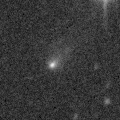
|
Now it is 16.5 mag (Dec. 20, Michael Jager). It must have been observable at 16-17 mag in good condition from summer to autumn in the Northern Hemisphere, but it was not discovered. It will be fading after this, and will be fainter than 18 mag in April.
Date(TT) R.A. (2000) Decl. Delta r Elong. m1 Best Time(A, h)
Feb. 20 11 49.30 32 13.7 1.705 2.603 149 16.8 1:54 (180, 23)
Feb. 27 11 33.89 31 5.8 1.722 2.648 154 16.9 1:11 (180, 24)
|
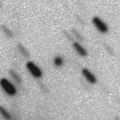
|
Now it is bright as 16.0 mag (Jan. 29, Sandor Szabo). It keeps observable in good condition for a while.
Date(TT) R.A. (2000) Decl. Delta r Elong. m1 Best Time(A, h)
Feb. 20 5 35.87 12 36.9 3.008 3.515 113 16.9 20:19 (166, 41)
Feb. 27 5 38.30 12 13.8 3.116 3.530 106 16.9 20:08 (162, 41)
|
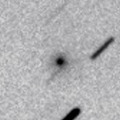
|
Now it is 16.8 mag (Dec. 18, Space Surveillance Telescope, Atom Site). It will be fading after this, and will be fainter than 18 mag in Apri. It locates somewhat low in the Southern Hemisphere.
Date(TT) R.A. (2000) Decl. Delta r Elong. m1 Best Time(A, h)
Feb. 20 8 13.84 25 11.9 1.106 2.019 149 16.9 22:15 (180, 30)
Feb. 27 8 13.88 25 30.1 1.163 2.037 142 17.0 21:47 (180, 30)
|
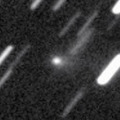
|
Now it is 17.0 mag (Dec. 16, Purple Mountain Observatory). It will be fading after this, and will be fainter than 18 mag in Apri. It locates somewhat low in the Southern Hemisphere.
Date(TT) R.A. (2000) Decl. Delta r Elong. m1 Best Time(A, h)
Feb. 20 7 48.61 27 16.0 1.489 2.356 143 17.1 21:49 (180, 28)
Feb. 27 7 47.51 28 10.3 1.547 2.359 135 17.2 21:21 (180, 27)
|

|
Now it is 18.3 mag (Nov. 15, Hidetaka Sato). It keeps observable at 17 mag in good condition from winter to spring.
Date(TT) R.A. (2000) Decl. Delta r Elong. m1 Best Time(A, h)
Feb. 20 15 5.30 2 10.6 2.066 2.529 106 17.1 4:07 (204, 50)
Feb. 27 15 9.58 2 17.6 1.995 2.538 111 17.1 4:16 (192, 52)
|

|
Now it is 18.6 mag (Feb. 13, M. M. Knight, M. S. P. Kelley, S. Protopapa, M. Micheli). It will pass only 0.024 a.u. from the earth on Mar. 23. It is expected to brighten very rapidly and reach up to 12 mag in March. It is observable in excellent condition in the Northern Hemisphere. In the Southern Hemisphere, it keeps observable in excellent condition until mid March, but it will be low after that. The orbital elements are similar to those of 252P/LINEAR.
Date(TT) R.A. (2000) Decl. Delta r Elong. m1 Best Time(A, h)
Feb. 20 5 43.72 -36 15.2 0.245 1.064 101 17.7 20:19 ( 78, 83)
Feb. 27 5 46.28 -35 25.6 0.195 1.038 98 17.1 20:08 ( 85, 80)
|
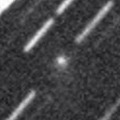
|
Now it is 17.5 mag (Dec. 17, Space Surveillance Telescope, Atom Site). It keeps observable at 17-18 mag until summer in the Northern Hemispehre. It is not observable after March in the Southern Hemisphere.
Date(TT) R.A. (2000) Decl. Delta r Elong. m1 Best Time(A, h)
Feb. 20 6 24.90 42 34.9 1.771 2.444 122 17.1 20:25 (180, 12)
Feb. 27 6 11.76 44 52.3 1.850 2.413 112 17.2 20:08 (176, 10)
|
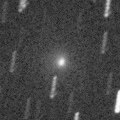
|
First return of a periodic comet discovered in 2003. It brightened up to 15.1 mag in December (Dec. 17, Space Surveillance Telescope, Atom Site). Now it is fading. It will be fainter than 18 mag in March. It is observable in excellent condition in the Northern Hemisphere. It locates low in the Southern Hemisphere.
Date(TT) R.A. (2000) Decl. Delta r Elong. m1 Best Time(A, h)
Feb. 20 5 20.22 36 10.2 1.260 1.855 110 17.2 20:19 (168, 18)
Feb. 27 5 33.12 37 10.5 1.354 1.889 106 17.5 20:08 (167, 16)
|

|
It was observed as bright as 13-14 mag for a long time from 2011 to 2014. Now it is fading. It is observable in excellent condition in the Southern Hemisphere. It locates extremely low in the Northern Hemisphere.
Date(TT) R.A. (2000) Decl. Delta r Elong. m1 Best Time(A, h)
Feb. 20 18 12.37 -31 35.1 9.499 9.018 58 17.2 4:07 (285, 39)
Feb. 27 18 13.27 -31 54.1 9.425 9.052 65 17.2 4:16 (282, 46)
|

|
It has not been observed in this apparition yet. It will brighten up to 16 mag from March to June. It is observable in excellent condition in the Southern Hemisphere. It locates somewhat low in the Northern Hemisphere.
Date(TT) R.A. (2000) Decl. Delta r Elong. m1 Best Time(A, h)
Feb. 20 15 30.07 -10 41.3 1.655 2.037 97 17.5 4:07 (224, 59)
Feb. 27 15 37.59 -12 18.8 1.570 2.029 102 17.3 4:16 (214, 64)
|
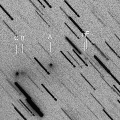
|
First return of a periodic comet which brightened up to 8 mag in major outburst in 2010. It will be observable in excellent condition from winter to spring. However, now it is faint; the fragment A is 17.8 mag (Feb. 8, Ken-ichi Kadota), the fragment B is 19.0 mag (Feb. 11, Michael Jager), the fragment C is 17.0 mag (Feb. 8, Ken-ichi Kadota). It will be 17 mag at best in this apparition. Fragments D to I are also observed in early February.
Date(TT) R.A. (2000) Decl. Delta r Elong. m1 Best Time(A, h)
Feb. 20 8 48.77 34 12.5 0.657 1.593 150 17.4 22:49 (180, 21)
Feb. 27 8 46.75 32 39.2 0.667 1.584 145 17.3 22:20 (180, 23)
|

|
It has not been observed yet in this apparition. It tends to be brightest after the perihelion passage. It is observable at 17 mag in excellent condition until March in the Northern Hemisphere. It locates low in the Southern Hemisphere.
Date(TT) R.A. (2000) Decl. Delta r Elong. m1 Best Time(A, h)
Feb. 20 5 31.38 38 13.4 1.054 1.702 112 17.3 20:19 (171, 16)
Feb. 27 5 44.99 36 58.8 1.098 1.698 108 17.4 20:08 (170, 17)
|
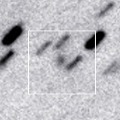
|
Now it is 16.9 mag (Dec. 19, Y. Sugiyama). It keeps 17.5 mag for a long time from 2016 to 2019. It keeps locating near by the equator.
Date(TT) R.A. (2000) Decl. Delta r Elong. m1 Best Time(A, h)
Feb. 20 8 0.03 0 40.2 9.229 10.063 145 17.4 22:01 (180, 54)
Feb. 27 7 58.89 0 59.1 9.274 10.051 139 17.4 21:32 (180, 54)
|
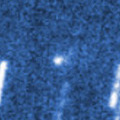
|
Now it is 17.8 mag (Dec. 18, Hidetaka Sato). It keeps observable at 17.5 mag in good condition until April.
Date(TT) R.A. (2000) Decl. Delta r Elong. m1 Best Time(A, h)
Feb. 20 8 26.15 13 33.0 1.749 2.675 154 17.5 22:26 (180, 41)
Feb. 27 8 19.02 17 15.8 1.776 2.651 145 17.5 21:52 (180, 38)
|
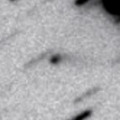
|
Now it is 17.6 mag (Dec. 17, A. Hidas). It keeps 17-18 mag for a long time until 2017 spring.
Date(TT) R.A. (2000) Decl. Delta r Elong. m1 Best Time(A, h)
Feb. 20 6 34.56 -18 6.9 3.377 3.954 119 17.6 20:35 (180, 73)
Feb. 27 6 33.93 -16 10.2 3.411 3.932 114 17.6 20:08 (179, 71)
|
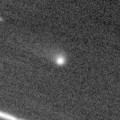
|
It brightened up to 16 mag in early 2015. Now it is 18.1 mag (Dec. 12, ATLAS-HKO, Haleakala). It is observable at 18 mag from winter to spring.
Date(TT) R.A. (2000) Decl. Delta r Elong. m1 Best Time(A, h)
Feb. 20 9 30.13 -23 35.0 5.274 6.100 143 17.7 23:30 (180, 79)
Feb. 27 9 21.88 -22 57.0 5.301 6.124 143 17.7 22:54 (180, 78)
|
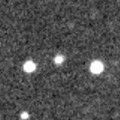
|
Now it is 17.9 mag (Jan. 23, T. Vorobjov). The cometary activity is confirmed recently. It is expected to brighten up to 7 mag in 2017 spring. But it locates somewhat low at the high light.
Date(TT) R.A. (2000) Decl. Delta r Elong. m1 Best Time(A, h)
Feb. 20 11 48.78 -5 57.0 4.667 5.546 150 17.8 1:53 (180, 61)
Feb. 27 11 45.33 -5 38.9 4.552 5.481 157 17.7 1:22 (180, 61)
|
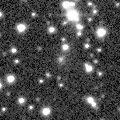
|
It will pass the perihelion in 2019. However, it has not been brightening since the discovery in 2010. Now it is 17.6 mag (Dec. 3, D. Buczynski). It keeps observable in excellent condition in the Northern Hemisphere, although it becomes low temporarily in May. It is not observable in the Southern Hemisphere.
Date(TT) R.A. (2000) Decl. Delta r Elong. m1 Best Time(A, h)
Feb. 20 3 9.46 46 48.2 10.578 10.590 88 17.7 20:19 (150, -2)
Feb. 27 3 10.73 46 45.8 10.659 10.567 82 17.8 20:08 (148, -4)
|
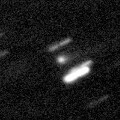
|
It brightened up to 15.2 mag in early 2015 (Feb. 24, Toshiyuki Takahashi). Now it is 17.5 mag (Dec. 6, Catalina Sky Survey). It will be fainter than 18 mag in April.
Date(TT) R.A. (2000) Decl. Delta r Elong. m1 Best Time(A, h)
Feb. 20 11 35.25 -5 58.2 3.900 4.801 152 17.8 1:39 (180, 61)
Feb. 27 11 32.29 -5 42.7 3.877 4.820 160 17.8 1:09 (180, 61)
|
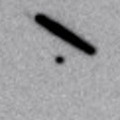
|
Now it is 17.4 mag (Jan. 13, Ken-ichi Kadota). It is observable in good condition in the Northern Hemisphere. It is not observable in the Southern Hemisphere.
Date(TT) R.A. (2000) Decl. Delta r Elong. m1 Best Time(A, h)
Feb. 20 10 30.19 53 40.7 1.735 2.552 137 17.8 0:35 (180, 1)
Feb. 27 10 17.40 53 12.4 1.800 2.599 135 17.9 23:49 (180, 2)
|
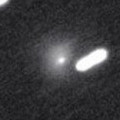
|
Very far object. Outburst occured on Feb. 20, 2015, and it brightened up to 15 mag. But it is faint as 18 mag now. It is observable in excellent condition in the Southern Hemisphere. It locates somewhat low in the Northern Hemisphere.
Date(TT) R.A. (2000) Decl. Delta r Elong. m1 Best Time(A, h)
Feb. 20 13 33.06 -26 21.7 8.647 9.154 118 17.8 3:37 (180, 81)
Feb. 27 13 32.37 -26 23.7 8.554 9.156 124 17.8 3:09 (180, 81)
|
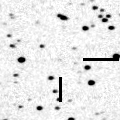
|
It was discovered around the aphelion in 2013 December. It keeps observable at 17 mag in good condition from 2016 to 2017. No observations have been reported since 2014 March.
Date(TT) R.A. (2000) Decl. Delta r Elong. m1 Best Time(A, h)
Feb. 20 13 2.09 1 57.9 2.302 3.094 136 18.0 3:06 (180, 53)
Feb. 27 12 59.88 2 19.1 2.206 3.063 143 17.8 2:36 (180, 53)
|
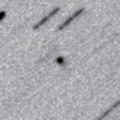
|
It keeps 17.5 mag from 2016 to 2017. It is observable in good condition in the Northern Hemisphere. In the Southern Hemisphere, it locates low in 2016, and it is not observable in 2017.
Date(TT) R.A. (2000) Decl. Delta r Elong. m1 Best Time(A, h)
Feb. 20 17 22.47 15 30.1 6.729 6.563 76 17.9 4:07 (232, 21)
Feb. 27 17 24.81 16 37.2 6.626 6.548 81 17.8 4:16 (224, 25)
|

|
Now it is 17.7 mag (Nov. 30, Hidetaka Sato). It was expected to brighten up to 14 mag from winter to summer. But it is much fainter actually. It will be observable in excellent condition in the Southern Hemisphere. It locates low in the Northern Hemisphere.
Date(TT) R.A. (2000) Decl. Delta r Elong. m1 Best Time(A, h)
Feb. 20 15 50.47 -24 43.7 2.053 2.275 89 17.9 4:07 (253, 65)
Feb. 27 16 0.57 -26 11.7 1.992 2.290 94 17.9 4:16 (249, 71)
|
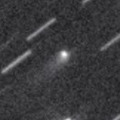
|
It keeps 17-18 mag for a long time since 2013. In the Northern Hemisphere, it is observable at 18 mag in good condition also in this winter. It is not observable in the Southern Hemisphere.
Date(TT) R.A. (2000) Decl. Delta r Elong. m1 Best Time(A, h)
Feb. 20 14 3.76 61 22.7 6.967 7.435 114 17.9 4:07 (180, -6)
Feb. 27 13 55.47 62 12.4 6.976 7.458 115 17.9 3:32 (180, -7)
|

|
It will graze the surface of the sun on Apr. 10. It will pass only 0.16 a.u. from the earth on Mar. 13, and will be observable in excellent condition.
Date(TT) R.A. (2000) Decl. Delta r Elong. m1 Best Time(A, h)
Feb. 20 14 28.25 -6 17.8 0.620 1.361 113 20.3 4:07 (192, 61)
Feb. 27 14 56.50 -4 57.0 0.440 1.236 113 19.1 4:16 (188, 60)
|
|
![]()
 118P/Shoemaker-Levy 4
118P/Shoemaker-Levy 4 C/2014 N3 ( NEOWISE )
C/2014 N3 ( NEOWISE ) C/2015 T4 ( PanSTARRS )
C/2015 T4 ( PanSTARRS ) C/2014 Q1 ( PanSTARRS )
C/2014 Q1 ( PanSTARRS ) C/2015 B2 ( PanSTARRS )
C/2015 B2 ( PanSTARRS ) C/2015 YG1 ( NEOWISE )
C/2015 YG1 ( NEOWISE ) C/2015 X4 ( Elenin )
C/2015 X4 ( Elenin ) 204P/LINEAR-NEAT
204P/LINEAR-NEAT 211P/Hill
211P/Hill 180P/NEAT
180P/NEAT P/2016 BA14 ( PanSTARRS )
P/2016 BA14 ( PanSTARRS ) C/2015 W1 ( Gibbs )
C/2015 W1 ( Gibbs ) 329P/2015 T1 ( LINEAR-Catalina )
329P/2015 T1 ( LINEAR-Catalina ) C/2010 S1 ( LINEAR )
C/2010 S1 ( LINEAR ) 100P/Hartley 1
100P/Hartley 1 331P/2015 Y2 ( Ikeya-Murakami )
331P/2015 Y2 ( Ikeya-Murakami ) 194P/LINEAR
194P/LINEAR C/2014 B1 ( Schwartz )
C/2014 B1 ( Schwartz ) C/2015 Y1 ( LINEAR )
C/2015 Y1 ( LINEAR ) C/2015 X7 ( ATLAS )
C/2015 X7 ( ATLAS ) C/2013 G9 ( Tenagra )
C/2013 G9 ( Tenagra ) C/2015 ER61 ( PanSTARRS )
C/2015 ER61 ( PanSTARRS ) C/2010 U3 ( Boattini )
C/2010 U3 ( Boattini ) 269P/2012 R2 ( Jedicke )
269P/2012 R2 ( Jedicke ) 162P/Siding Spring
162P/Siding Spring C/2013 C2 ( Tenagra )
C/2013 C2 ( Tenagra ) P/2013 YG46 ( Spacewatch )
P/2013 YG46 ( Spacewatch ) C/2014 OE4 ( PanSTARRS )
C/2014 OE4 ( PanSTARRS ) C/2014 Y1 ( PanSTARRS )
C/2014 Y1 ( PanSTARRS ) C/2012 K8 ( Lemmon )
C/2012 K8 ( Lemmon ) 321P/SOHO
321P/SOHO![]()



















































